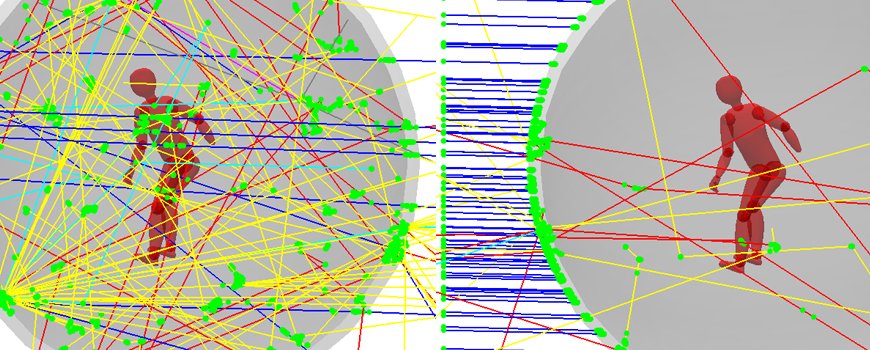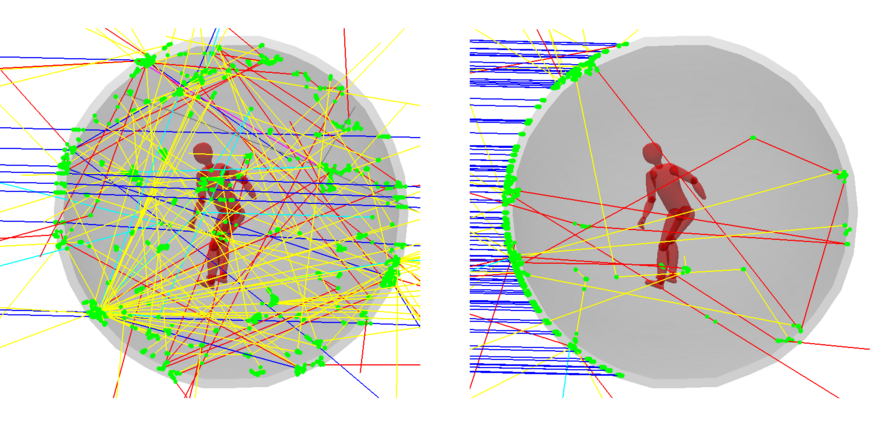Space radiation is one of the main concerns in planning long-term human space missions. Both, Solar Energetic Particles (SEP) and Galactic Cosmic Rays (GCR) from space are dangerous to humans. An international team led by Yuri Shprits from the GeoForschungsZentrum Potsdam (GFZ) and the University of Potsdam, as well as Mikhail Dobynde from the Skolkovo Institute of Science and Technology (Skoltech) in Moscow, has now used simulations to show that a mission to Mars will be an extreme technological challenge, but still viable. The researchers were looking at the different types of radiation and their propagation through space as well as inside a spacecraft with a human phantom. The framework conditions determined: The spacecraft thickness should be sufficient to protect the astronauts from the incoming radiation but not too thick to reduce the number of secondary particles generated in the shielding materials. Even in an optimally designed satellite, the mission should not exceed four years. And it should be launched during the peak of solar activity, as solar activity shields the particularly dangerous radiation from outside the solar system. The results were published in the scientific journal Space Weather.
The threat of space radiation
A journey to Mars takes about nine months in one direction, according to the current state of the art. While people on Earth and in near-Earth orbits are protected from space radiation by the Earth's body and its magnetic field, the radiation poses a considerable risk for journeys into deeper space, such as to Mars. Astronauts are exposed to two types of dangerous radiation: energetic particles of solar origin (SEP), which are mainly protons, and galactic cosmic rays (GCR). GCR also comprises mainly protons (84%), as well as positively charged alpha particles (two protons + two neutrons, 14%) and negatively charged electrons (2%). Protection against these particles is technically very difficult and costly because they fly through space at very high energies and can therefore penetrate deep into materials or even pass through them. They can also create new secondary energetic particles in the shield of the spacecraft. These energetic particles can be damaging to the skin and even to inner organs.
Simulations by an international team
In order to estimate how much astronauts are exposed to space radiation and to find the optimal conditions for a mission to Mars, the researchers simulated various radiation situations and protection options. In addition to the main authors Yuri Shprits (GFZ) and Michail Dobynde (Skoltech Moscow), a former graduate student of Shprits, colleagues from MIT and the University of California, Los Angeles (USA) were involved.
First, they determined the radiation environment for the spacecraft, i.e. the type and energy of the particles to which it is exposed during its mission. Therefore, they relied on SEP measurements from 1998 to 2012 and used an empirical model of the GCR that is dependent on the solar cycle.
Influence of the solar cycle on both types of radiation
The intensity of the two types of radiation varies during the eleven-year solar cycle, which is characterised by the solar magnetic field changing polarity: the magnetic north and south poles flip places. Different types of solar activity also exhibit an 11-year periodicity. For example, solar flares occur, in which intense bursts of radiation are released in an explosive event, propagating into the solar system. However, the dangerous high-energy solar particles (SEP) are only sporadically produced in this way. A precise prediction of the timing, strength and direction of the radiation is a great challenge. What is clear, however, is that the probability and intensity of solar radiation is highest at the peak of solar activity.
In contrast, Galactic Cosmic Rays (GCR) are more persistent. Although particle fluxes are not as high, radiation doses can add up dangerously during long travel times in space. Cosmic rays are also influenced by solar activity: they are weakest when shielded by the maximum solar activity.
Radiation effects on spacecraft and crew
To investigate the effect of radiation on the spacecraft and the astronauts, the former was modelled by a sphere with an inner diameter of two metres. The researchers chose the common aluminium as the material for the shell, while varying the thickness of this protective shell. A water sphere with a diameter of 35 centimetres served as a model for the human body.
On this basis, the researchers finally calculated the radiation dose that accumulates in the body during a journey to Mars under different conditions. They also analysed different penetration depths into the body to differentiate the sensitivity of skin, blood forming and other organs.
Result: optimal conditions for a flight to Mars
"Until now, most of the space agencies assumed that the total radiation exposure for astronauts during their lifetime should not exceed 1 Sievert," says Yuri Shprits. The new calculations show that this threshold can be met if the spacecraft has optimal shielding, the flight is launched during the solar maximum, and if the total travel time does not exceed 3.8 years.
For the aluminium shield, a material thickness of 30 grams per square centimetre proves to be optimal. It is remarkable that the principle "more helps more" cannot be applied here according to the investigations: If the material becomes thicker, more scattering processes occur inside, creating more so-called secondary particles, which can increase the radiation exposure inside the spacecraft again. For thinner shielding the critical dose would be achieved even during shorter flights.
Outlook concerning new materials and future missions
If there are new findings on the biological effectiveness of radiation and new material developments, the presented models can be adapted.
"We have initially concentrated here on aluminium as the currently common material for the radiation shield. Composite materials such as carbon fibre composites (CFRP), which are peppered with light elements such as hydrogen, have also been discussed for some time. On these materials, we would observe fewer scattering processes and therefore fewer secondary-induced particles," Shprits predicts. Overall, however, this should only lead to an improvement in the protective effect of around 20 per cent, the space physicist estimates. This would then make it possible to extend the travel time by one year.
At same time the detailed effects of different types of radiation on the human body are not fully understood and the limiting dose and type of dose may be revised in the future, which could potentially further limit the potential flight duration.
It should be also noted that the solar cycle can significantly vary with varying effects that cannot be well predicted. This must be taken into account when planning future missions.
Original study: M.I. Dobynde, Y.Y. Shprits, A.Yu. Drozdov, J. Hoffman, J. Li, Beating 1 Sievert: Optimal Radiation Shielding of Astronauts on a Mission to Mars, Space Weather 2021, DOI: 10.1029/2021SW002749
Scientific contact:
Prof. Yuri Shprits
Section head Space physics and space weather
Helmholtz Centre Potsdam
GFZ German Research Centre for Geosciences
Telegrafenberg
14473 Potsdam
Phone: +49 331 288-28899
Email: yuri.shprits@gfz-potsdam.de
Media contact:
Dr. Uta Deffke
Public and Media Relations
Helmholtz Centre Potsdam
GFZ German Research Centre for Geosciences
Telegrafenberg
14473 Potsdam
Phone: +49 331 288-1049
Email: uta.deffke@gfz-potsdam.de









![[Translate to English:] Torsten Sachs in front of a climate station on a field](/fileadmin/_processed_/3/9/csm__TorstenSachs_bearbeitet_GS_4a1365ef84.jpeg)

![[Translate to English:] left image flood at the Ahrtal: image from above, several houses are flooded; left image:: Heidi Kreibich;](/fileadmin/_processed_/4/4/csm_Bild2_9af0130e9f.png)



![[Translate to English:] Start der Vega Rakete](/fileadmin/_processed_/6/4/csm_20231201-kachel_Vega-VV23-launch_ESA-CNES-Arianespace_706716b68c.jpeg)









![[Translate to English:] Poster exhibition at the Brandenburg Hydrogen Day at the GFZ, some participants in the foreground](/fileadmin/_processed_/6/5/csm_Erster_Brandenburgischer_Wasserstofftag_GFZ_402fcec95e.jpeg)
![[Translate to English:] Group picture of the participants](/fileadmin/_processed_/9/4/csm_20231108_CAWa-Workshop-Tashkent_Gruppenbild_99ea779d8a.jpeg)

![[Translate to English:] [Translate to English:] Hörsaal](/fileadmin/_processed_/e/6/csm_H%C3%B6rsal_e21ac645fb.jpeg)


![[Translate to English:] The Delegations in the Historic Library on the Telegrafenberg. In the back there are from left to right, the Dutch Ambassador for Germany, Ronald van Roeden, the Dutch Minister for Education, Culture and Science, Robbert Dijkgraaf and the scientific director of the GFZ, Susanne Buiter.](/fileadmin/_processed_/d/b/csm_Kachel-2_9eba4b4212.jpeg)

